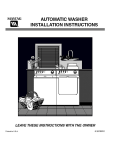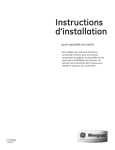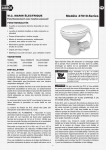Download Maytag LAT9356AAE User`s guide
Transcript
Read this before you start… TOOLS needed for installation: • Cutting knife • Channel lock • Nut driver • Level • Crescent wrench • Screwdriver-flatblade Proper installation is the responsibility of the purchaser. SERVICE CALLS PERFORMED AS A RESULT OF POOR INSTALLATION ARE THE RESPONSIBILITY OF THE INSTALLER. Make sure you have everything necessary for proper installation. 3 1 5 4 2 1 GROUNDED ELECTRICAL OUTLET is required. See Electrical Requirements. 2 STANDPIPE DRAIN SYSTEM must be able to accept 1 1/2” O.D. drain hose. Standpipe height of 36” is recommended. NOTE: Unit is designed to pump efficiently to a height of 8 feet at normal spin speeds. 3 HOT AND COLD WATER FAUCETS must be within 4 feet of the back of the washer. 4 LAUNDRY TUB DRAIN SYSTEMS (for use with Water-Saver Models only). Tub capacity to hold a minimum of 21 gallons. 5 WATER HEATER set to deliver 140°F (60°C) hot water to the washer. 6 PROTECTION FROM WEATHER: Do not store or operate washer below 60°F (15°C). PARTS supplied for installation: • 2 inlet hoses • 4 hose washers • 2 hose screens • 1 cable tie • Literature package INSTALLATION ACCESSORY KITS Part No. Description Application 12001875 Grounding Kit Additional grounding if required by local codes. 12001585 Drain Hose Extension Extends drain hose for drain facilities higher than 4 ft. 12001586 Anti-Siphon Used when an air-tight connection exists between drain hose and drain facility. Floor drain facilities. 12001599 Small Diameter Standpipe Drain Hose Used when standpipe diameter is too small to receive end of drain hose. 211692 Non-Slip Disc For painted / sloped basement floors. 204986 Carpet Installation Disc For carpeted floors. AUTOMATIC WASHER INSTALLATION INSTRUCTIONS LEAVE INSTALLATION INSTRUCTIONS AND USER’S GUIDE WITH THE OWNER 6 2305670 Printed in U.S.A. REQUIREMENTS GROUNDING ELECTRICAL 120 Volt 60 Hz 15 AMP Fuse Individual branch circuit serving only the washer is recommended. The washer is equipped with a power cord. NEVER USE AN EXTENSION CORD. ELECTRICAL GROUND IS REQUIRED ON THIS APPLIANCE. Appliance is equipped with a power cord having a 3-prong grounding plug for use in a properly installed and grounded outlet. Additional Ground Procedure (where local codes permit): It is recommended an additional ground be installed. A proper external ground MUST be determined prior to wire hookup. Consult local building officials and qualified electrician if in doubt. For additional grounding a grounding kit (Part No. 12001875) containing accessory ground wire, clamp, ground screw and washer can be purchased. Contact your authorized Maytag dealer for further assistance. Follow ALL grounding requirements and codes. EXPORT MODELS – 50 HZ AND 60 HZ A washer must be used on the voltage and frequency it was designed for. It should be operated on an individual branch circuit and fused by no less than a 15 amp fuse or circuit breaker for 120 volt units or 10 amp fuse or circuit breaker on 220–240 volt units. Export models may require the addition of a plug on the power cord. It is the responsibility of the installer to assure that this has been done properly. Check the data plate to be sure of voltage and line frequency requirements. EXPORT–specific grounding instructions must be determined due to variation of electrical services. WATER Water pressure of 20 to 120 p.s.i. is required to correctly fill the washer to the proper levels. Pressures of less than 20 p.s.i. may cause a failure to the water valve. The valve might not shut off completely. TO AVOID THE POSSIBILITY OF WATER DAMAGE, SHOULD A HOSE LEAK, ALWAYS HAVE FAUCETS ACCESSIBLE AND TURN OFF FAUCETS WHEN WASHER IS NOT IN USE. CABINET DIMENSIONS 26 3/4” 68.0 cm 36” 91.4 cm 36” 91.4 cm 43” 110.8 cm 51” 129.5 cm 25” 64.8 cm SIDE VIEW BACK VIEW DRAIN FACILITY FLOORING Recommended height of standpipe is 36”. If the standpipe is less than 36” high, the drain hose should be routed through the clip to raise the hose to the proper height. The standpipe must be large enough to accept a 1 1/2” outside diameter drain hose. For best performance the washer must be installed on a solidly constructed floor. Wood floors may need to be reinforced to minimize vibration and/or unbalanced load situations. Carpeting and soft tile surfaces are also contributing factors in vibration and/or tendency for a washer to move slightly during spin cycle. Never install washer on a platform or weak supported structure. Without the 36” high elevation, water may run out of the washer prematurely. A possible sign that the drain hose has not been elevated to proper height is if the washer fills and drains at the same time. The drain hose is attached at factory. (See Installation Accessory Kits table.) WATER SAVER MODELS The diverter valve is located in the lower lefthand corner on the backside of the washer. The suds hose (hose with long gooseneck) connects to the top diverter valve outlet. The other end of the hose is cut at an angle to prevent sediment from returning to the washer. Place suds hose into a 21 gallon minimum capacity storage tank. This hose must be in a straight line to the storage tank and be able to reach the bottom of the tank. Secure the hose to the tank to prevent the hose from coming out. The drain hose is connected to the bottom diverter valve outlet. The other end goes into the standpipe. If the standpipe is less than 36” high, the drain hose should be routed through the clip to raise the hose to the proper height. If the drain hose needs to be extended to reach the drain facility, attach the extension hose section to the siphon break using a coupler. LOCATION CONSIDERATIONS It is recommended the washer never be installed in areas where water may freeze, since the washer will always maintain some water in the water valve, pump and hose areas. This can cause damage to belts, pump, hoses and other components. Operating temperature should be above 60°F. COLD WEATHER STORAGE The following precautions should be taken if a washer is to be stored where it would be subject to freezing conditions. 1. Turn off the water supply, remove and drain inlet hoses. 2. Select a fill cycle and energize the water valve by selecting a warm water setting. A few seconds of fill is sufficient. 3. Disconnect from electrical supply. 4. Use flat blade screwdriver to release two clips at bottom corners of front panel. Remove front panel. 5. Remove the hose clamps and drain the water from the drain hose and pump by lowering the drain hose to floor level. Do not extend gooseneck end or cut gooseneck end off. Be sure each section of hose is securely pushed over the ends of the coupler and should join at approximately the middle of the coupler. Now with the drain hose elevated 36”, it can go into a floor drain or low standpipe. STEP 1 STEP 5 • Remove all items from inside of wash tub. • Replace tub block and tape lid shut. • Remember! After installation is completed, the tub block needs to be removed. Run water through both water faucets into a bucket to purge the water line particles that might clog the hoses. While running water through the faucets, determine which faucet is HOT water and place an identifying mark on it. Traditionally the HOT water faucet is on the STEP 2 • Lay two carton corner posts on the floor. • Make sure one corner post is placed against the wooden crate bottom. • Tip washer forward on its front so it will lay across both corner posts. STEP 6 Insert one screen and then one washer into the faucet ends of the inlet hoses. The screens should be pointing out to fit properly. STEP 3 • Remove crate wires and crate base. STEP 7 Attach the inlet hoses to the HOT and COLD faucets. Being sure the hose marked “HOT” is attached to the HOT water faucet. Tighten by hand until snug and then 2/3 of a turn with pliers. Do not overtighten. STEP 4 • Tip machine upright. • Slide washer in place near water faucets. • Prepare to hook up hoses. Attach the inlet hoses to the HOT and COLD connections on the back of the washer. HOT and COLD connections are identified by H & C stamped on the bracket, HOT on top, COLD on bottom. Be sure the hose marked “HOT” is attached to the HOT connection. Tighten by hand until snug and then 2/3 of a turn with pliers. Do not overtighten. STEP 8 Turn on faucets and check for leaks at the faucets and at the machine connections. If leak occurs, check for cross-threaded or loose connections. HOSE RETAINER STEP 9 CLIP STANDARD MODELS 36” standpipe recommended • If standpipe is less than 36” (or floor drain) – drain hose should be routed through the clip to raise hose to the proper height. WATER SAVER MODELS The diverter valve is located in the lower lefthand corner on the backside of the washer. The suds hose is a two-piece hose and connects to the top diverter valve outlet. A wire strainer is partially inserted into the end of the gooseneck (C) to prevent sediment from returning to the washer. The suds hose (C) should be placed into a 21 gallon (minimum capacity) storage tank. This hose must be able to reach the bottom of the tank. Installation of Hoses: • Lower suds hose (A) connects to the top diverter valve outlet. Use hose clamp to secure. Diverter Valve A STEP 10a Place the drain hose in the drain facility. If the hose is twisted after it has been placed in the drain, adjust the end of the hose to remove the twist. To remove the twist, turn the short end of the hose while holding the base of the hose stationary. NOTE: If you must make an airtight seal, an antisiphon kit must be used. Coupler B C Wire Strainer B A Hose Clamps • Insert wire strainer into “long leg” of upper suds hose (C). • Install Coupler: Slide one clamp onto the upper suds hose (C) and one clamp onto the lower suds hose (A). – Join the two ends of the upper (C) and lower (A) suds hoses using the plastic coupler. Be sure each end of the hoses are securely pushed over the end of the coupler…the hoses should join at approximately the middle of the coupler. Use hose clamps to secure both ends of coupler. • Drain hose (B) connects to the bottom diverter valve outlet. Use hose clamp to secure. • Insert the gooseneck (B) end of the drain hose into a 36” standpipe. NOTES: a.) If a 36” standpipe is not available, insert the drain hose (B) into the plastic clip on the backside of the washer to maintain a 36” height. b.) If an airtight seal must be made with the standpipe, or a floor drain is used, then an antisiphon kit must be used. B To prevent accidental dislodging secure the drain hose to the standpipe, inlet hose or laundry tub with the tie strap provided in the parts package. STEP 11 • With a level, check washer and make necessary adjustments to leveling legs. Wire Strainer C Clamps Coupler Step 10b Plastic Clip A STEP 12 Clamps • Once level, tighten leveling leg locking nuts with wrench. REMINDER! Proper installation is the responsibility of the purchaser. SERVICE CALLS PERFORMED AS A RESULT OF POOR INSTALLATION ARE THE RESPONSIBILITY OF THE INSTALLER. For best performance the washer must be installed on a solidly constructed floor. Wood floors may need to be reinforced to minimize vibration and/or unbalanced load situations. Carpeting and soft tile surfaces are also contributing factors in vibration and/or tendency for a washer to move slightly during spin cycle. Never install washer on a platform or weak supported structure. STEP 13 STEP 16 • Check machine again with a level. • Be sure that machine does not rock. • Remove tape from lid. • Open lid to remove tub block. • Remove any remaining shipping material, including protective dial cover(s). • Improper connection of the equipment-grounding conductor can result in a risk of electrical shock. Check with a qualified electrician or serviceman if you are in doubt as to whether the appliance is properly grounded. Do not modify the plug provided with the appliance – if it will not fit the outlet, have a proper outlet installed by a qualified electrician. ! WARNING IMPORTANT SAFETY PRECAUTIONS • To prevent unnecessary risk of fire, electrical shock or personal injury, all wiring and grounding must be done in accordance with the National Electrical Code ANSI/NFPA 70-Latest Revision (for U.S.) or the Canadian Electrical code CSA C22.1 – Latest Revision and local codes and ordinances. It is the personal responsibility and obligation of the appliance owner to provide adequate electrical service for this appliance. STEP 17 • Check operation using the check list. CHECK LIST STEP 14 If a separate ground is required by local codes: A grounding kit (Part No. 12001875) containing the ground wire, clamp, ground screw and washer needs to be purchased. Connect ground wire to back of unit using the ground screw and washer. Secure other end of ground wire with clamp to COLD metal water pipe. NEVER CONNECT GROUND WIRE TO PLASTIC PLUMBING LINES, GAS LINES OR HOT WATER PIPES. STEP 15 • Plug power cord into properly grounded electrical outlet. ■ Tub block, accessory package and instructions have been removed from tub. ■ Washer is properly grounded and plugged into a polarized electrical outlet. ■ Water is turned on. Check for leaks at faucet and water valve connections. ■ Drain hose is properly located in drain facility and hose is not kinked. ■ Washer has been leveled with legs firmly on floor, leveling legs lock nuts have been tightened. ■ Fill washer. Check for correct water temperature. ■ After washer has filled, let washer agitate. ■ Spin water out. ■ Demonstrate washer usage to consumer. Be sure to leave these instructions and the User’s Guide with the















